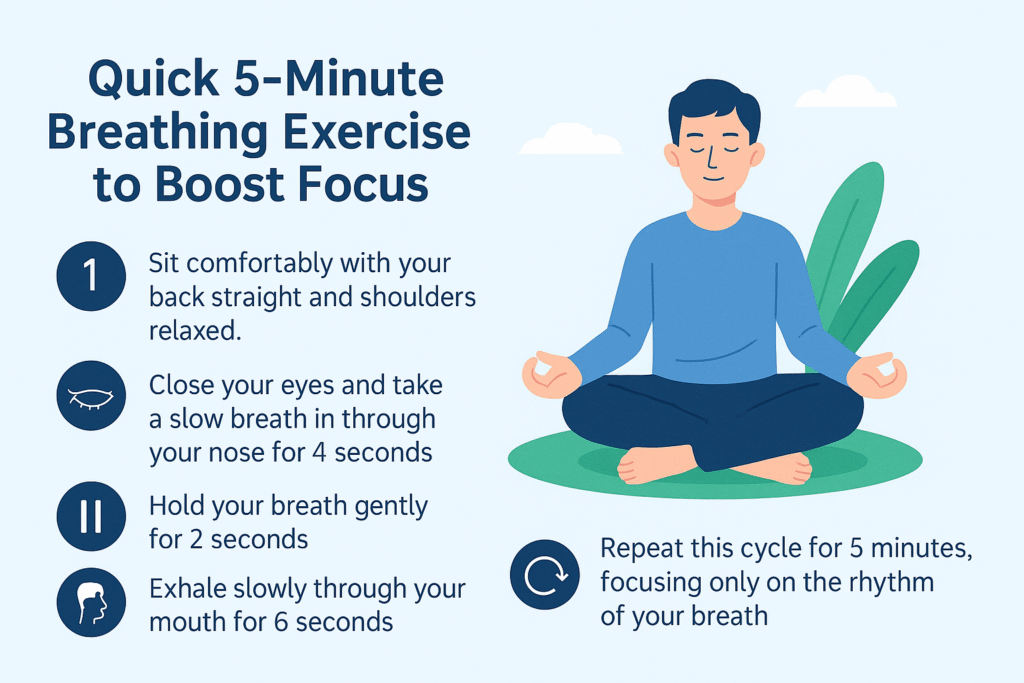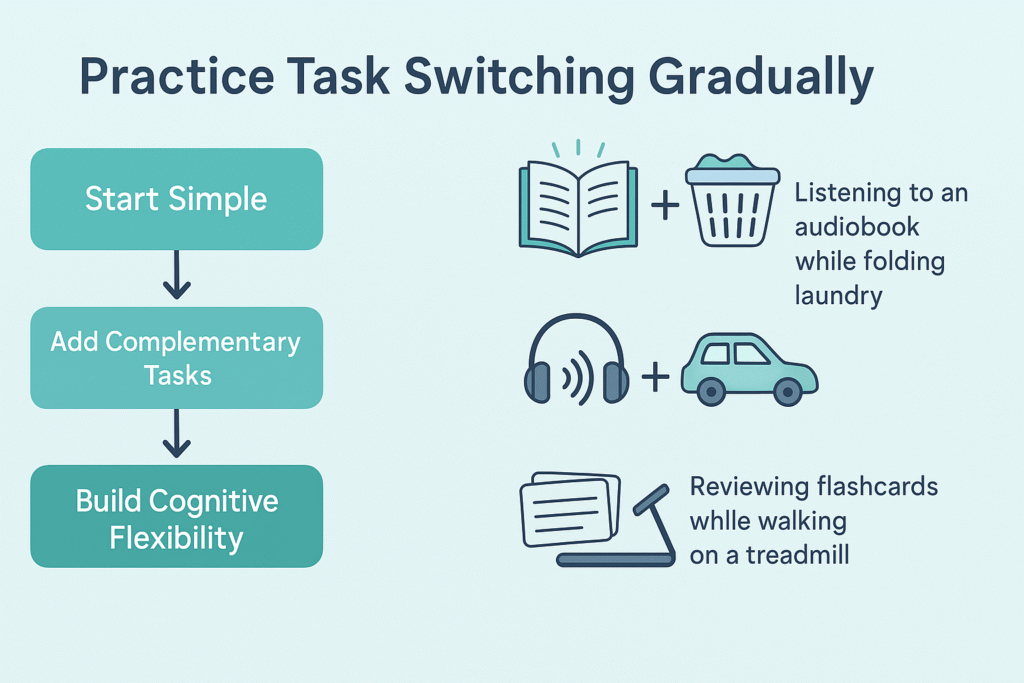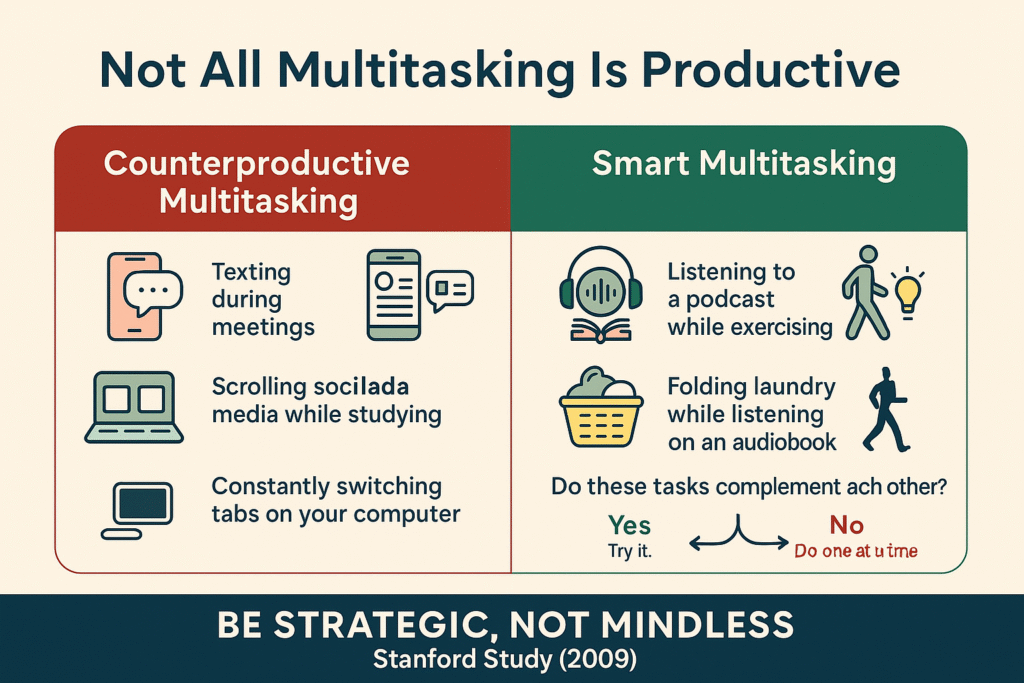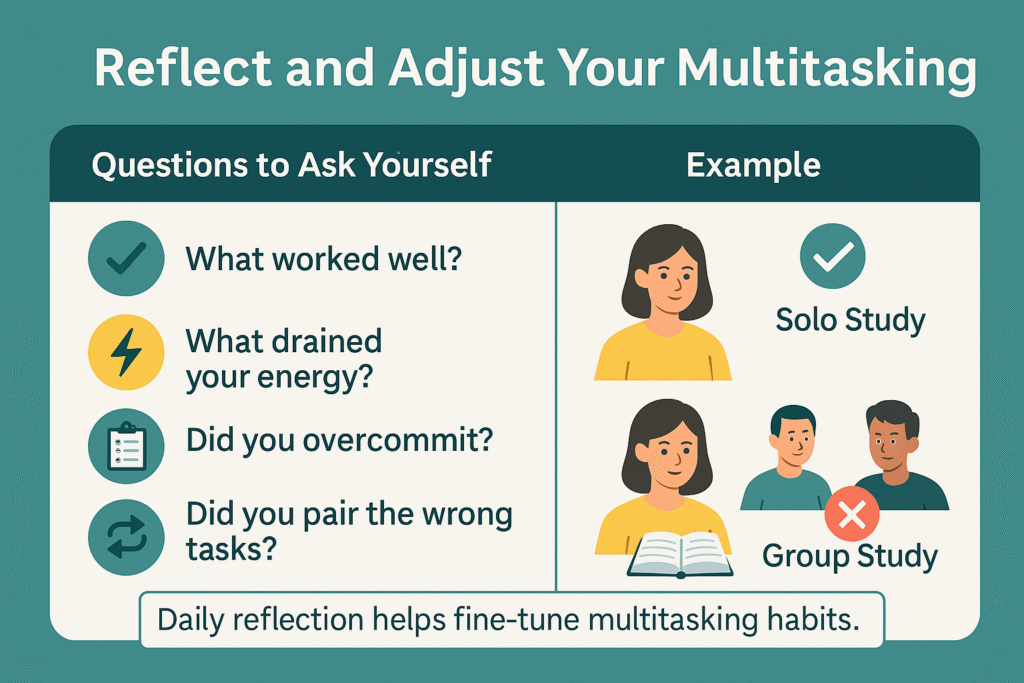Introduction
As a parent, managing family responsibilities and completing work before the deadline as a professional are very common responsibilities in everyone’s life. Performing these responsibilities at once is no longer an option but has become a necessity in today’s fast-paced world. So, under this situation, learning multitasking skills can help you achieve maximum output during minimum time.
But here the truth you need to understand is that effective multitasking is not about doing everything at once wildly; it’s about managing tasks smartly. According to a study by the American Psychological Association (APA, 2001), if you frequently switch tasks, your efficiency reduces up to 40%. However, researchers also found that if you manage different tasks with proper planning and time management, it will not only enhance your efficiency but also reduce stress. Hence, improving multitasking skills is not about working harder, but about working smarter.
Why Multitasking Skills Matter
Modern life demands finishing multiple tasks efficiently. For example, let’s suppose that you are doing work as a project manager. You have to perform multiple tasks, like coordinating with team members, attending meetings and preparing presentations in a single day. Without sharp multitasking skills, you will start feeling overwhelmed and ultimately result in poor performance.
Research published in the Journal of Experimental Psychology (2009) found that people who consciously built abilities to handle multiple tasks perform better under tense situations as compared to those who don’t. This shows that multitasking is not a difficult task; it depends on how you approach it. Let’s have a deep dive to learn more about multitasking skills:
How to Improve Multitasking Skills
1. Prioritize and Organize Tasks
Prioritising and organising tasks are simple but highly impactful multitasking skills. This practice makes you realise that every task which you feel is urgent is not actually urgent. Eisenhower Matrix techniques help you categorise tasks into urgent, important or unnecessary. In our daily routine, we usually waste energy doing tasks which are urgent but not important. Research found that successful people invest energy in doing tasks which are important but not urgent.
Let’s explain it with a simple example. A marketing executive can use this method to focus on client presentations first (urgent and important), schedule social media posts later (important but not urgent), and skip unnecessary email chains (not important). When tasks are prioritised, multitasking becomes structured instead of overwhelming.
2. Use Time Blocking
Time blocking is another important way to improve multitasking skills. Time blocking means you allocate specific time for all relevant and similar tasks. Research from Harvard Business Review (2018) shows that grouping related tasks together helps you feel less tired and makes you more efficient.
For example, instead of randomly checking emails and social media notifications throughout the day, only allocate 30 minutes in the morning and evening. This way, you avoid constant distractions and become more focused. It ultimately improves your productivity.
3. Train Your Brain with Mindfulness
Random thoughts and distractions don’t let us focus on one thing. So, it looks difficult to focus on one thing at a time. This is where mindfulness comes in. Mindfulness doesn’t mean that you sit in one position for hours. It actually trains your brain to stay present and focused on a particular thing for a long duration.
Studies show that mindfulness not only strengthens working memory (the part of your brain that holds and organises information) but also enhances cognitive flexibility (your ability to switch between tasks smoothly). In other research, Jha et al. (2010) concluded that mindfulness training improves attention control, which is the most effective tool to handle multiple tasks without losing focus.
For example, if you have to do multiple tasks like submitting a report before the deadline, attending an online meeting and checking client emails. Instead of rushing into all three, take a break for just five minutes. Close your eyes, take slow deep breaths and focus only on your breathing. This quick reset clears away distractions and helps your brain “reset”, so when you jump into your tasks, you can move between them with sharper focus and less stress.
Quick 5-Minute Breathing Exercise to Boost Focus:
- Sit comfortably with your back straight and shoulders relaxed.
- Close your eyes and take a slow breath in through your nose for 4 seconds.
- Hold your breath gently for 2 seconds.
- Exhale slowly through your mouth for 6 seconds.
- Repeat this cycle for 5 minutes, focusing only on the rhythm of your breath.
Think of mindfulness as a physical workout; the more you practise it, the stronger your brain becomes.

4. Leverage Technology Wisely
Technology can play a pivotal role in doing multiple tasks if used wisely; meanwhile, its misuse can create problems with lasting impacts. On one side, technology helps to organise projects wisely and solve problems within minutes. On the other hand, constant notifications can scatter your focus and make simple things overwhelming. So, the key is not just using technology but using it wisely.
Research from the American Psychological Association (2016) shows that different task management tools like Trello, Notion, Asana, or Google Calendar not only reduce workload but also help you to stay mentally fresh, which leads to better output.
However, constant notifications from social media apps divert your attention from important tasks and ultimately result in poor performance. Studies have found that it can take up to 23 minutes to regain focus after a single interruption. That’s why setting boundaries with technology is very important for effective multitasking.
Practical Tip:
- Silence non-essential notifications.
- Use “Do Not Disturb” mode during deep work sessions.
- Batch-check emails and messages at set times instead of reacting instantly.
For example, if someone is working as a freelance graphic designer, using an app like Google Calendar may help him to keep all project deadlines visible on one dashboard. This helps the designer to focus on one project at a time without forgetting others. In short, you shouldn’t let the technology control you; instead, it should serve you. When you manage technology properly, it becomes your best partner in handling multiple responsibilities smoothly.
5. Practice Task Switching Gradually
Trying multitasking without first practising it often leads to stress and mistakes. The best way is to train your brain step by step. Just like winning a marathon without first practising shorter runs is impossible, similarly, handling multiple tasks is just a dream without training the mind. Start by pairing two simple, complementary activities. For example,
1. Listen to an audiobook while doing laundry; this turns boring work into learning time.
2. Catch up on your favourite podcasts during travelling. It makes travelling more productive.
3. Review flashcards while walking on a treadmill so you can exercise your body and brain at the same time.
These combinations train your brain to switch between tasks smoothly. Research conducted by the University of Michigan (2009) found that gradual task switching actually builds new cognitive pathways that make the brain adapt faster when handling complex tasks in life.

6. Avoid Multitasking Pitfalls
People believe that doing multiple tasks at once makes you more productive. In reality, some type of multitasking badly affects your performance. For example, scrolling social media during study and replying to texts during a work meeting may feel like multitasking, but in reality, these kinds of multitasking only cause distraction and result in poor performance. Instead of training your mind for multitasking, these practices ruin your focusing ability and lead to more mistakes.
Backed by research, a Stanford University study (2009) revealed that people who engage in heavy media multitasking, constantly switching between emails, scrolling videos and messaging, are more likely to get distracted and struggle with long-term memory compared to those who multitask less.
So, without proper planning, multitasking can’t bring fruitful results. Try to pair up those tasks that complement each other, like listening to a podcast while driving, which can be useful. In contrast to this, doing attention-demanding activities at once only slows down progress.

7. Reflect and Adjust
If you want to improve multitasking skills, you have to work on it on a daily basis. It’s not something you can get Excel overnight. It is actually a continuous process of learning, testing and adjusting. The best way to grow is to reflect at the end of each day. Ask yourself simple but powerful questions:
- Which activities performed well together today?
- Which task wasted my energy?
- What are the main distractions I faced today?
- Did I pair tasks that clashed instead of complementing each other?
By reflecting, reviewing and adjusting each day will not only improve multitasking skills but also make each day more productive and efficient than the last.
For example, if you are preparing for an exam, then directly joining a group study can make you feel overwhelmed. By simply adjusting this approach in a way that first you do the study by yourself and then join the group session, it will bring more fruitful results. This practice will not only boost retention but also reduce stress. In short, reflection helps you separate what works from what doesn’t, allowing you to build smarter multitasking routines that save time, protect energy, and improve results.

Conclusion
In today’s fast-paced world, multitasking is no longer optional. It has become a necessity, and we all face this reality on a daily basis. The real challenge isn’t to avoid multitasking but to manage it strategically so it works for you instead of against you. So a wise approach to multitasking can save time, reduce stress, and help you accomplish more without wasting your energy.
The key lies in adopting practical strategies:
- Prioritise effectively so the most important tasks always get done.
- Use time-blocking to focus on related activities in dedicated slots.
- Practise mindfulness to sharpen your focus and reduce mental clutter.
- Leverage technology wisely, using tools to organise tasks while cutting out distractions.
- Reflect and adjust daily to fine-tune your multitasking habits over time.
When you integrate these practices, multitasking transforms from a source of chaos into a powerful productivity tool. Instead of spreading yourself too thin, you’ll be able to balance multiple responsibilities with clarity and control.
Final Thought: True productivity doesn’t come from doing everything at once. It comes from doing the right things, in the right way, at the right time. If you can master this balance, you’ll not only get more done but also enjoy the journey with less stress and more satisfaction.
References
https://www.indeed.com/career-advice/career-development/multi-tasking-skills
https://cirkus.com/blog/multitasking-skills
https://www.monitask.com/en/blog/5-proven-strategies-for-enhancing-your-multitasking-abilities
https://www.amanet.org/articles/secrets-of-multitasking-slow-down-to-speed-up
https://www.abby.com/blog/how-to-be-better-at-multitasking
FAQs
Can I train myself to multitask?
The ability to multitask develops through practice. Learning efficient multitasking techniques will help you decrease workday stress while boosting productivity and making your work more enjoyable.
What is the secret to successful multitasking?
Reduce distractions
Your ability to focus becomes impaired when you encounter distractions while multitasking. Your ability to multitask will improve when you minimize workplace interruptions. You can eliminate distractions through two methods: You should keep your office door shut when performing tasks which require your complete concentration.


